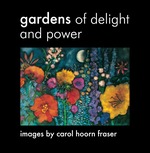About the Author: Carol Hoorn Fraser
Carol Hoorn Fraser, (1930 – 1991), RCA, grew up in Superior, Wisconsin, and obtained an MFA at the University of Minnesota, where she studied under art historian Lorenz Eitner, aesthetician John Hospers, and poet Allen Tate, among others, wrote her thesis on “The Human Image in Contemporary Painting," and took top awards in major shows at the Walker Art Center and the Minneapolis Institute of Art. In 1961 she moved with her husband John to Halifax, Nova Scotia, where she lived until her death, with stays in Provence and Mexico. Her works are in the Walker Art Center, the Smithsonian Institute, the National Gallery of Canada, the Beaverbrook Art Gallery, and other public galleries.

Carol Hoorn Fraser, MFA, RCA (1930-1991) was a beautiful and unique American-born artist, who received a humanistic art education at the University of Minnesota, took first prizes in shows at the Walker Art Center and the Minneapolis Institute of Art, and lived for thirty years in Nova Scotia with her husband John, with stays in Provence and Mexico.
Like Sinatra, she did it her way, radically rethinking her popular expressionist style in the mid-Sixties and developing a decisive organicist iconography in oils that was all her own. Subsequently, when asthma became a problem, she embarked on a brilliant series of watercolours, returning to oils shortly before her death.
Gardens of Delight and Power shows her at the top of her game, equally inventive and colour-rich in both mediums, with Mexico, which she visited six times, a strong presence. The gardens range from a great moon-glowing avenue of cypresses in Provence, to the interior of a car magically filled with green forms together with a reclining nude in the glove compartment, to a sheer uncontrolled burst of Mexican night blossoms. These twenty-one images are a joyous celebration of energy and order, with a few darker notes to remind us of their preciousness.
Her work is represented in numerous public collections, including the Walker Art Center, the Smithsonian Institute, the National Gallery of Canada, and the Beaverbrook Art Gallery.
 Carol Hoorn Fraser, MFA, RCA (1930-1991) was a beautiful and unique American-born artist, who received a humanistic art education at the University of Minnesota, took first prizes in shows at the Walker Art Center and the Minneapolis Institute of Art, and lived for thirty years in Nova Scotia with her husband John, with stays in Provence and Mexico.
Carol Hoorn Fraser, MFA, RCA (1930-1991) was a beautiful and unique American-born artist, who received a humanistic art education at the University of Minnesota, took first prizes in shows at the Walker Art Center and the Minneapolis Institute of Art, and lived for thirty years in Nova Scotia with her husband John, with stays in Provence and Mexico.